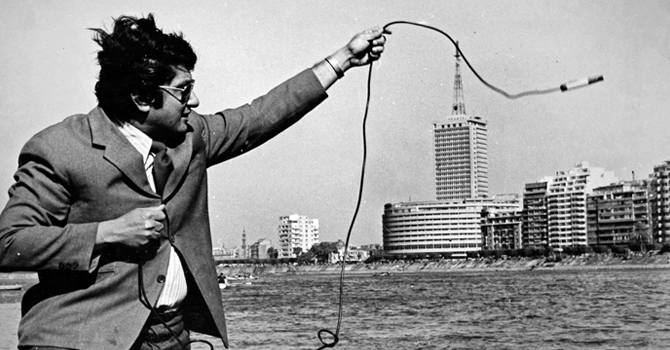Healthy Water, Healthy People

Khalil Hosny Mancy
Professor Emeritus of Environmental Health Sciences
Above: Khalil Hosny Mancy, professor emeritus of Environmental Health Sciences, lowers an oxygen sensor into the Nile River as it runs through Cairo in 1971.
Khalil Hosny Mancy taught at the University of Michigan from 1965-2000 and is known around the world for his groundbreaking contributions to environmental chemistry, including water quality management, pollution control technology, environmental quality monitoring, and toxic chemical and hazardous waste management.
In 1962, Mancy’s doctoral work led to the development of the Galvanic Cell Oxygen
Analyzer (see photo), which gave field scientists, for the first time ever, the ability
to instantaneously measure dissolved oxygen concentration in water
systems at any surface depth. Dissolved oxygen is a primary water quality metric,
and Mancy’s oxygen analyzer quickly became an indispensable tool for anyone doing
water quality assessments.
Mancy sought to foster more peaceful relations between Israel and Palestine through dialogue and scientific collaboration on the issue of water rights.
Mancy and his students at Michigan developed methods for field measurement of ozone and chlorine dioxide gases to disinfect drinking water and developed biofilm electrodes for rapid field detection of toxic chemicals and viruses in water—methods useful in providing healthy, sustainable water supplies to a variety of populations.
In addition to his many scientific discoveries, Mancy is also remembered for his humanitarian efforts. As a native of Egypt, he was committed to the improvement of public health in Egypt and across the Middle East, and he developed a number of collaborations with public health professionals in the region. In particular, he sought to foster more peaceful relations between Israel and Palestine through dialogue and scientific collaboration on the issue of water rights. Throughout his career, Mancy worked closely with friend and colleague Hillel Shuval, MPH ’52, professor emeritus of environmental sciences at the Hebrew University of Jerusalem and the Hadassah Academic College in Jerusalem.
Mancy and Shuval’s collaborative science helped protect the region’s scarce and fragile water resources.
Shuval was born in the US and, beginning in 1948, lived and worked in Israel. With their two countries often formally at war, Mancy and Shuval spent decades conducting joint projects between Egyptian, Israeli, and Palestinian institutions. Their collaborative science helped protect the region’s scarce and fragile water resources. As they worked, they emphasized equitable access to shared water resources, an essential approach for both public health and peace in the Middle East.
In 2003, Mancy nominated Shuval for an honorary doctorate from the School of Public
Health, which the university awarded him in recognition of his achievements in environmental
science and his work to promote justice in the
Middle East.
Long before the dangers of global warming became clear to the scientific community, Mancy, Shuval, and many others in the field of public health were relentlessly pursuing protective measures for our most basic and valuable environmental resources and linking that work directly to concerns around health equity and environmental justice.
Mancy is retired and lives with his wife in the mountains of North Carolina. At 91 years old, he continues to be in touch with former students and colleagues.
—Samir Kelada, BS ’97, MPH ’00
Associate Professor of Genetics, University of North Carolina, Chapel Hill
